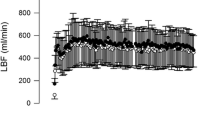Abstract
The Sheffield electrical impedance tomography; (EIT) system produces images of changes in the distribution of resistivity within tissue. The paper reports on the application of electrical impedance tomography in monitoring volume changes in the limb during venous occlusion. The aim of the study is to assess the feasibility, reproducibility and validity of calf blood flow measurements by EIT. In 14 healthy volunteers calf blood flow is compared, as determined in a calf segment by strain-gauge plethysmography (SGP), with the impedence changes measured by EIT during rest and post-ischaemic hyperaemia. The measurements are repeated to assess reproducibility. The reproducibility for the EIT, assessed from the repeated measurements and expressed as a reproducibility coefficient, is 0.88 during rest and 0.89 during hyperaemia. The reproducibility coefficient for SGP data is 0.83 at rest and 0.67 during hyperaemia. Flow measurements, assessed by means of two methods, correlate well at rest (r=0.89), but only moderately during hyperaemia (r=0.51). The correlation coefficient for the pooled flow measurements is 0.98. It is concluded that EIT is a valid and reliable method for assessing blood flow in the limb. Possible applications of EIT in localising fluid changes are discussed.
Similar content being viewed by others
References
Alpert, J. S., Coffman, J. D., Balodimos, M. C., Koncz, L., andSoeldner, J. S. (1972): ‘Capillary permeability and blood flow in skeletal muscle of patients with diabetes mellitus and genetic prediabetes’,N. Eng. J. Med.,286, pp. 454–460
Anderson, F. A., Durgin, W. W., andBrowell Wheeler, H. (1986): ‘Interpretation of venous occlusion plethysmography using a nonlinear model’,Med. Biol. Eng. Comput.,24, pp. 379–385
Baisch, F., Gauger, J., andHeer M. (1991): ‘Classification of the free fluid reservoir in the calf by electrical impedance tomography’,Physiologist,34, 1 suppl, pp. 181–182
Bland, J. M., andAltman, D. G. (1986): ‘Statistical methods for assessing agreement between two methods of clinical measurement’,Lancet,8, pp. 307–310
Brown, B. H., Leathard, A. D. Sinton, A. M., Mcardle, F. J., Smith, R. W. M., andBarber D. C. (1992): ‘Blood flow imaging using electrical impedance tomography’,Clin. Phys. Physiol. Meas.,13 A, pp. 175–179
Brown, B. H., andSeagar A. D. (1987): ‘The Sheffield data collection system’,ibid.,,8 A, 91–97
Guyton, A. C. (1991): ‘Textbook of medical physiology’, (W.B. Saunders Co, Philadelphia) pp. 170–183
Hillestad, L. J. (1963): ‘The peripheral blood flow intermittent claudication. V. Plethysmographic studies. The significance of the calf flow in rest and in response to timed arrest on the circulation’,Acta. Med. Scand.,174, p. 23
Jaap, A. J., Shore, A. C., Garside, I. B., Gamble, J., andTooke J. E. (1993): ‘Increased microvascular fluid permeability in young Type 1 (insulin dependent) diabetic patients’,Diabetolgia,36, pp. 648–652
Jindal, G. D., Nerurkar, S. N., Pedhnekar, S. A., Babu, J. P., Kelkar, M. D., Deshpande, A. K., andParulkar, G. B. (1990): ‘Diagnosis of peripheral arterial occlusive diseases using impedance plethysmography’,J. Postgrad. Med.,36, pp. 147–153
Katz, M. A. (1977): ‘Capillary filtration measurement by strain gauge. I. Analysis of methods’,Am. J. Physiol.,232 H, pp. 354–360
Kim, Y., Woo, H., andLuedtke, A. E. (1989): ‘Impedance tomography and its application in deep venous thrombosis detection’,IEEE Eng. Med. Biol. Mag.,8, pp. 46–49
Kooman, J. P., Wijnen, J. A. G., Draaijer, P., Van Bortel, L., Gladziwa, U., Peltenburg, H. G., Struyker-boudier, H. A. J., Van Hooff, J. P., andLeunissen, K. M. L. (1992): ‘Compliance and reactivity of the peripheral venous system in chronic inter-mittent haemodialysis’,Kidney Int.,41, pp. 1041–1048
Poulsen, H. I., andNielsen, S. L. (1976): ‘Water filtration of the forearm in short- and long-term diabetes mellitus’,Diabetolgia,12, pp. 437–440
Seagar, A. D., Gibbs, J. M., andDavis, F. M. (1984): ‘Interpretation of venous occlusion plethysmographic, measurements using a simple model’,Med. Biol. Eng. Comput,22, pp. 12–18
Smith, R. W. M., Freeston, I. L., andBrown, B. H. (1995): ‘A real time electrical impedance tomography system for clinical use— design and preliminary results’,IEEE Trans.,BME-31, pp. 133–140
Snedecor, G. W., andCochran, W. G. (1989): ‘Statistical methodsin (Iowa State University Press, Iowa) pp. 183–186
Sumner, D. S. (1985a): ‘Mercury strain-gauge plethysmography’,inBernstein, EF. (Eds.): ‘Noninvasive diagnostic techniques in vascular disease’, (C. V. Mosby, St Louis, Missouri) pp. 133–150
Sumner, D. S. (1985b): ‘Volume plethysmography in vascular disease: an overview’inBernstein, E. F. (Ed.): ‘Noninvasive diagnostic techniques in vascular disease’ (C. V. Mosby, St Louis, Missouri) pp. 97–118
Author information
Authors and Affiliations
Rights and permissions
About this article
Cite this article
Noordegraaf, A.V., Kunst, P.W.A., Janse, A. et al. Validity and reproducibility of electrical impedance tomography for measurement of calf blood flow in healthy subjects. Med. Biol. Eng. Comput. 35, 107–112 (1997). https://doi.org/10.1007/BF02534139
Received:
Accepted:
Issue Date:
DOI: https://doi.org/10.1007/BF02534139




